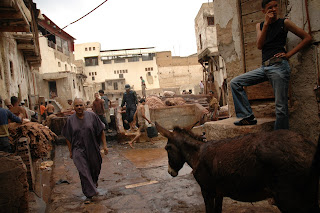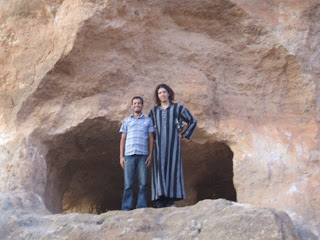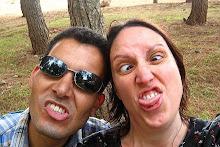Cave dwellers, far from being Neanderthals, may be the smartest beings on earth। Life protected from the elements by caves has persisted as a form of human existence for millennia, and goes on to this day in places such as Turkey, Tunisia, Afghanistan, Morocco, Italy, and France. In southern Spain, however, cave homes are man made, and not natural formations that humans simply moved into. Some of the very earliest names for the city of Granada refer to its cave dwellings. In nearby Benalua, a suburb of Guadix, everyone lives in a cave, just as in the gypsy quarter of Sacromonte. There are cave theaters, cave hotels, cave restaurants, cave spas, and of course, cave houses, known in Spanish as casas cueva. At the other end of the Sierra Nevada mountain chain too, near Almeria but still in Granada Province, cave dwelling has existed at least since the Arab invasion of Iberia in the 8th century. Granada Province has the largest cave dwelling population in Europe.
Here cave buildings do not, as might be expected, exist inside natural rock formations, like at Capadoccia in Turkey or the Tarn Gorge in France। Instead, they are intentional dwelling spaces carved out of hard clay and earth. Buying, refurbishing, or creating a new cave house represents the ultimate in efficient and sustainable living--though please be advised that we would not suggest building a cave house outside of regions where it is common practice and the structural integrity of the earth is well known. In Granada, the ancient cave dwelling area extends far beyond the contemporary city, into the hills and ravines of San Miguel Park, where some squatters still live, laying claim to caves without running water or electricity and living rent-free.
In southern Spain, cave houses naturally maintain a steady temperature of around 19-20 degrees centigrade year round. This is quite exceptional in a montane climate like Granada City where summertime temperatures surpass 40 degrees and where it occasionally snows in winter. Building a cave dwelling is relatively inexpensive (though not necessarily cheap), cave houses can have all the amenities of a regular house (and more), electricity, plumbing, and HVAC are easy to install, and cave houses remain dry and habitable with normal ventilation, unlike many stone caves that can store dampness. Even those with claustrophobia find modern cave houses quite comfortable.
After becoming accustomed to cave living, it is soothing to return to a home with the solidity of the earth and the silence of a church.
In Granada, the most geographically diverse province in the Iberian Peninsula, there exist distinct concentrations of cave settlement, notably in the historic Albaycin and Sacromonte neighborhoods of Granada City, in Guadix, on the other side of the majestic Sierra Nevada mountains, and in the more mountainous region of Baza। The Albaycin and Sacromonte are adjacent hillside neighborhoods, both of which form part of a UNESCO World Heritage Site along with the Alhambra Palace. They are ancient settlements, with cave dwelling existing at least back to Arab times, well before the 15th century. Guadix and Baza are similarly ancient cities. One likely historical explanation of cave building is that the Arabs brought the tradition with them from the troglodyte abodes of North Africa, starting in the early 700s. The total cave-dwelling population of the three areas runs into the tens of thousands. Some cave houses are extremely large, having up to ten or more rooms. Here there are specialists in cave construction, renovation, and expansion.
Advantages of Caves :
Caves are ecologically-friendly houses. Arguably, they are the most ecologically-sensitive form of construction, and could be combined with an alternative energy system to become almost completely sustainable. They maintain a constant indoor temperature with natural earth insulation, which also keeps them quiet. They do not require large amounts of inputs in terms of bricks, concrete, mortar, metal, or wood, and do not demand costly synthetic or ecologically-questionable construction materials. In fact, earth caves must be able to "breathe" naturally to last. Costs are therefore kept to a minimum, except for the expense of labor. Requirements for a completed house are limited to a natural floor finish such as terracotta tile or brick, a thin stucco-type wall and ceiling treatment (usually whitewashed; preferably a form of hydrated lime), mechanical systems, and fixtures. Earth caves can also be built to specification. Within certain limitations, one can have high or low ceilings, large or small rooms, curvilinear walls, domed or arched ceilings, alcoves, built-in furniture, and a catalog of sculptural room effects. In fact, building this kind of cave house is like sculpting your house from inside out--a most unique experience. No two cave houses are the same. Given enough land, you can also expand instantly and एअसिली।
Natural light can be provided not only from doors and/or windows facing the outside, but also by light ducts through holes that can be created by modern well-drilling rigs. Such light traps usually have convex Plexiglas covers and reflective ducting that capture and transmit the maximum amount of natural light deep into a cave house. A whitewashed cave interior also reflects more light throughout the interior space than one might think. Caves can even accommodate a fireplace, provided that it is placed relatively near the outside wall of the cave thus keeping chimney construction manageable. Built-in bathtubs, toilet alcoves, and closets are a snap for any experienced cave builder.
Cave homes have deeds and are protected by normal property rights in Spain। What happens if you transcend property boundaries or accidentally run into someone else's cave is not clear cut in the law. This is generally only a concern in areas with a high cave house density. Older, historic caves seem to have grandfathered rights, whether or not they penetrate beneath the lands of others.


















